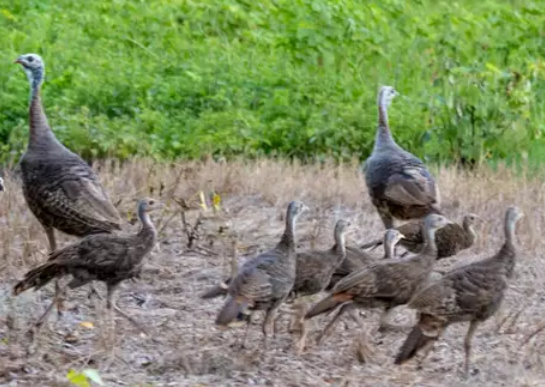Many of us are still surprised when a wild turkey is beside the road or off in a distant field. It is a wonderful sight to see a flock of turkeys slowly working their way across an open expanse. Most often what you see are hens and juveniles. Poults are young ones and will develop in three to four weeks with the ability to fly.
–
The eastern wild turkey as they are most often referred to were restored by introducing populations into strategic areas throughout the southeastern United States. Populations declined significantly over the first half of the twentieth century from loss of habitat and over hunting. Reintroductions began in the late 1970’s and continued until the 1990’s.
The need to reestablish forest areas too with the ability to produce significant food throughout the year for turkeys continues to be an issue. Additionally, sites for nesting, brooding, and roosting are all important for maintaining successful population growth. Turkeys roost in more mature trees or tall substantial shrubs. Turkeys are attracted to woodland areas of mature mixed hardwood and pine with high understory that is practically open as they have excellent eyesight yet like to move in an out of cover.
Cover is needed for the brooding and nesting time and at times can be difficult to find. Management for selected patchy yet continuous cover (shrubs) with a fallen log or two is a prime area for these steps of the turkey’s life. Establishing legumes that attract insects is also a critical part of these areas. Another important source that is needed nearby is one or two water locations, creeks and ponds serve this purpose well.
Poults or young turkeys need significant amounts of food as they grow quickly into adults. The best option as a landowner to attract turkeys is to areas of woodlands as described plus some open acreage of grass areas. The hens then can watch for predators, and this includes human activity, dogs and other wildlife that potentially could harm the flock. The reason for the varying food plots is their food pallet changes throughout winter, spring, summer, and fall. The food sources shift from acorns, dogwood fruit, holly fruits, multiple seeds and then shift to spiders, snails, wild blueberry, and other insects.
Turkeys move between large acreage areas as a part of their nature in pursuit of food, protection and water as the flock grows and matures. Food options shift with the time of year and this strongly impacts the flock movement. Another part of creating favorable sites for turkeys is prescribed burns of woodland areas as the understory openings allow for young seedling understory growth containing more food options. Mowing to keep areas open is also an option.
- Land Management to Enhance Wild Turkey in the Panhandle - September 29, 2023
- Healthy Forest Management - April 14, 2023
- Benefits of a Forestry Consultant - October 7, 2022

